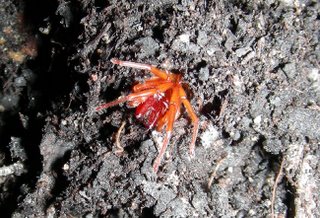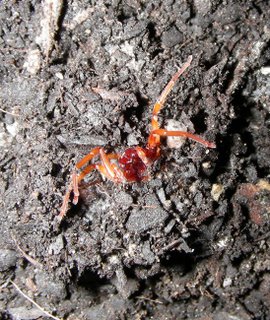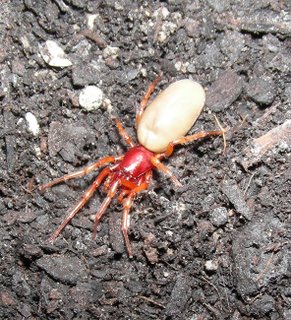 Meet Dysdera crocata. My garden is full of them. They're growing fat on the slaters that cluster under stones and timber.
Meet Dysdera crocata. My garden is full of them. They're growing fat on the slaters that cluster under stones and timber.The family is native to southern and eastern Europe (including the Canary Islands), the Middle East and North Africa. (A couple of species also occur in South America—an interesting biogeographical conundrum.) Of the numerous species, only Dysdera crocata has been transported around the world. It is now established in suitable habitats in other parts of Europe, in North America and Australia. (When first collected in Australia, it was thought to be a native species and given the name Dysdera australiensis. It wasn't until the 1960s that someone spotted the anomaly and identified it correctly.)
 In Australia, Dysdera crocata appears to be restricted to the south-eastern region. That may be due to under-reporting because its not a very outgoing species. It lives in damp locations under logs, rocks and garden refuse. Although it doesn't catch its prey in a web, Dysdera spins a sac-like retreat. This specimen is emerging from its retreat and is not happy about the camera.
In Australia, Dysdera crocata appears to be restricted to the south-eastern region. That may be due to under-reporting because its not a very outgoing species. It lives in damp locations under logs, rocks and garden refuse. Although it doesn't catch its prey in a web, Dysdera spins a sac-like retreat. This specimen is emerging from its retreat and is not happy about the camera.Dysdera tends to scuttle away when disturbed but occasionally gets shirty when threatened. The jaws are long and powerful enough to penetrate the exoskeleton of a slater, so they can pierce human skin with ease. The combination of stroppiness and strength make this spider something to avoid. But if you do get bitten, there's no need to panic.
 Vetter noted that it was repeatedly misidentified in the U.S. as the dangerous brown recluse spider (Loxosceles reclusa). When he looked at the records in detail, he found only eight verifiable bites. All of them resulted in local and short-lived effects. In one case, the patient also reported systemic effects—nausea, dizziness and lethargy but these did not persist. There was no necrosis (tissue death).
Vetter noted that it was repeatedly misidentified in the U.S. as the dangerous brown recluse spider (Loxosceles reclusa). When he looked at the records in detail, he found only eight verifiable bites. All of them resulted in local and short-lived effects. In one case, the patient also reported systemic effects—nausea, dizziness and lethargy but these did not persist. There was no necrosis (tissue death).(I was bitten by a huntsman spider some months ago and that was much worse. Only local effects but they lasted for quite a while. The story of how I got bitten is a long and daft one, which will only confirm that I really need to be in some sort of home for the feeble-minded. On the other hand, the story of how I got stung by a little marbled scorpion, Lychas marmoreus, demonstrates that shit really can happen. It was on a towel at a B & B. What are the odds?)
Read more
Vetter, R.S. & Isbister, G.K. (2006). Verified bites by the woodlouse spider, Dysdera crocata. Toxicon 47: 826–829.